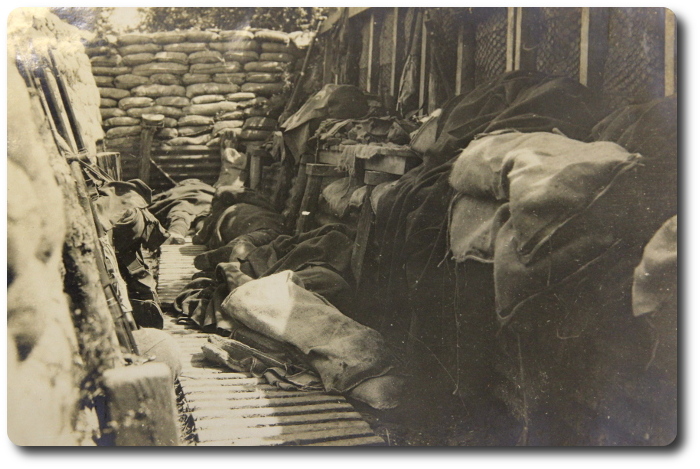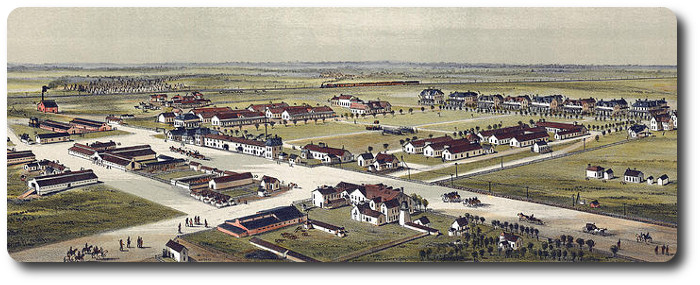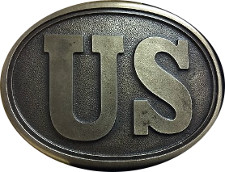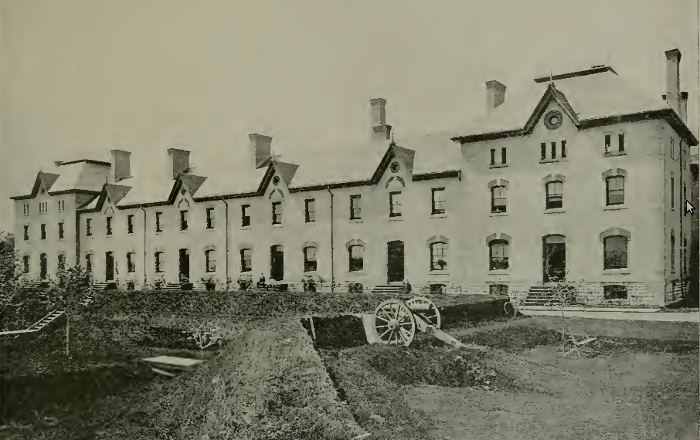Dugouts
Topic: CEF
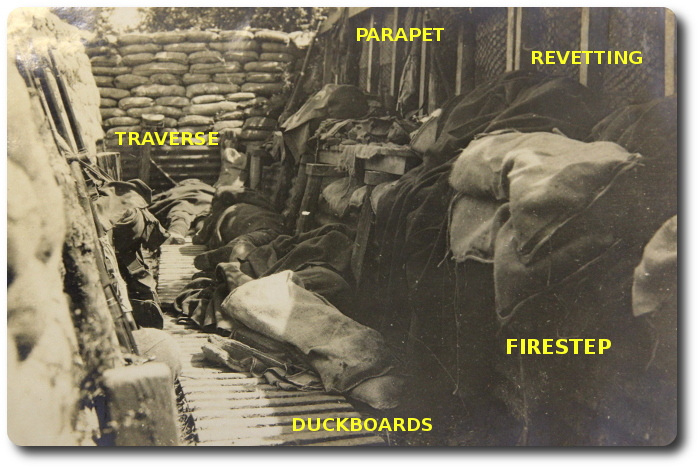
Dugouts
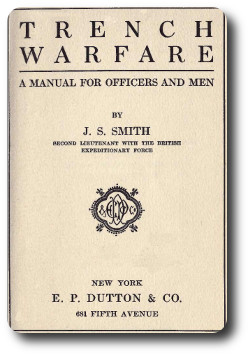 Trench Warfare; A Manual for Officers and Men,, J.S. Smith, Second Lieutenant with the British Expeditionary Force, E.P. Dutton & Co., 1917.
Trench Warfare; A Manual for Officers and Men,, J.S. Smith, Second Lieutenant with the British Expeditionary Force, E.P. Dutton & Co., 1917.
It is only under very exceptional circumstances that under-cutting a trench wall is allowed, and then the shelter should be cut in the rear wall only. These shelters must be carefully supervised and watched by the officer, as men are very often careless, with the result that the shelters are dug in a hurry and poorly. Then it rains, the shelter falls in, and the men are no more, It should be high enough for a man to sit up straight, and long enough for him to lie down in, and deep enough for two men to lie side by side. It should be raised at least a foot above the floor level in the trench to prevent water from the trench floor coming in. A shelter smaller than these dimensions is useless. It has a demoralizing effect, destroying all activity, mental and physical. These shelters can only be properly made by cutting into the rear trench wall the necessary depth and length and right to the top. Then, with any material which is convenient, such as corrugated iron, brush wood, old rubber sheets, revet the sides and back. A corrugated iron roof is supported on posts at a depth of about a foot to a foot and a half below the normal level of the ground. Then, when possible, cover this with rubber sheets. If not possible to procure rubber sheets, simply cover with dirt excavated from shelter, taking care that it does not rise higher than your parados.
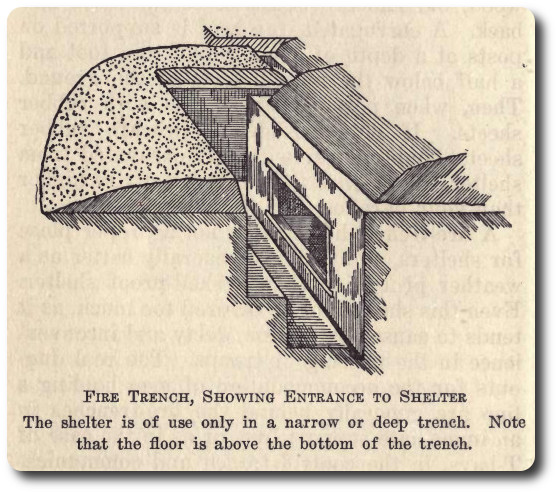
A fire-trench, however, is not a proper place for shelters, and they are generally better as a weather protection than a shell-proof shelter. Even this should not be favored too much, as it tends to cause obstruction, delay and inconvenience in the passing of troops. The real dugouts for the accommodation of men holding a line are generally behind the fire-trenches in an immediate support line, or as in the case of T-bays, in the control trench and communication trenches leading to and from them. These are large dug-outs, having a depth of 30 and 40 feet, and in some cases capable of holding 100 to 250 men, generally having from 5 to 10 exits and entrances. Here the men stay during bombardments and are generally safe from any caliber shell which may light on top, unless a half dozen should light in the same particular spot.
This work is generally of a very skilled and technical kind. Plans, drawings and labor are supervised by the engineers, expert tunnelers being used in constructing work, although the infantry supplies working parties to dispose of the dirt, etc., resulting from these excavations and to carry the materials and tools needed and required in the construction.
The design and general scheme of a small dugout which can be made by the infantry under the supervision of an officer, without the aid of an engineer, are here given.
The dugout should be approximately 6 feet from floor to roof and about 8 feet wide, with an approximate length of 12 feet, thus allowing men to lie down and yet leave room for passage through. The width depends upon the number you intend to have occupy it. Each man requires 18". Depth to be dug below ground depends entirely to what extent you may raise the roof upon the ground without making an unduly exposed hump which will at once tell the enemy a dugout is there. The thickness of the roof should be approximately 6 feet, constructed with sideposts, cross beams, corrugated iron, water proof oilcloth, sandbags and soil. Sandbag revetments should be used in the strengthening of side posts. When possible, although hardly ever so, walls should be lined with waterproof oilcloth and entrances so placed that they get as much sun as possible.
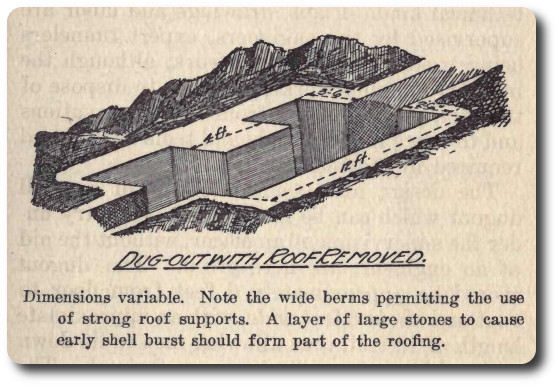
Great care and attention must be given to these dugouts, and even though taking a little longer than seems necessary, care must be taken to see that they are substantially constructed, otherwise they are in a constant source of danger of cave-ins during heavy shelling and bad weather. Not more than 10 men should occupy one of these dugouts. Then, if accidents happen, your casualties are not so great.
The roof of these dugouts should be prepared in a manner tending to withstand as high shell shock as possible, and for this purpose the following table would be of some use, any part of which, or a combination of all, will give some idea of what is required.
Resistance of Roof Materials
(a) Shrapnel bullets—Stout planks suitably supported and covered with corrugated iron and 12" of earth or 3" of shingle.
(b) Ordinary guns of 3" caliber—Strong timber supporting 4 ft. of earth with a top layer of heavy stones or broken bricks to cause early shell burst.
(c) Field howitzers (of less than 6" caliber)—12" logs, supporting 8 ft. of earth with top layer of heavy stones or broken brick and lightly covered over with some earth.
(d) "Jack Johnsons"—20 ft. of earth or 10 ft. of cement concrete, reinforced with steel and covered over with a covering of heavy stone or broken brick.
It is very often the case that there is a line of trenches with very few dugouts. Those that exist are mainly occupied by first aid stations with a medical officer in charge, and officers' headquarters. When such is the case, very narrow, deep trenches, known as retirement trenches, are dug roughly from 20 to 50 yards behind the firing line, so that every one, except those on sentry duty, may retire there during the heavy shelling. It is very obvious that excellent communication must be kept up between trench and the firing line.
Joseph Shuter Smith
Joseph Shuter Smith was an American author born in Philadelphia in 1893. He spent his childhood in Alaska during the Gold Rush and spent his years before the Great War as a lumberjack, miner, surveyor and cowboy. In 1914, continuing his adventurous streak, he went to Canada and enlisted in the Canadian Expeditionary Force, declaring his birthplace to be Port Hope, Ontario (with next of kin in Oakland, California). Smith enlisted with the 29th Canadian Infantry Battalion at Vancouver. He served in France and Belgium as a soldier in the CEF and, after being commissioned in August, 1916, as an officer of the British Army with The Royal Scots (Lothian Regiment). He resigned his Imperial commission after a year to return to the US and enlist in the American Army. Joseph Smith also wrote the memoir: Over There and Back in Three Uniforms; Being the Experiences of an American Boy in the Canadian, British and American Armies at the Front and through No Man's Land.

Posted by regimentalrogue
at 12:01 AM EDT
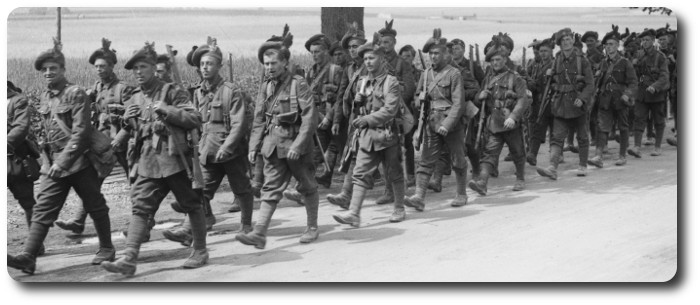


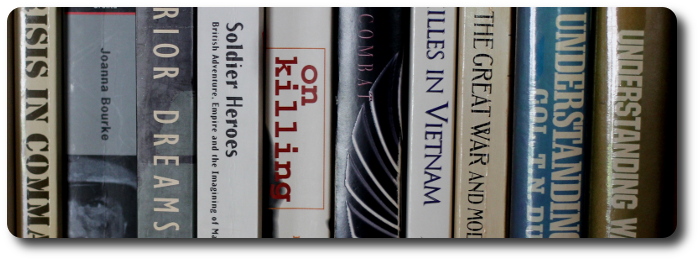
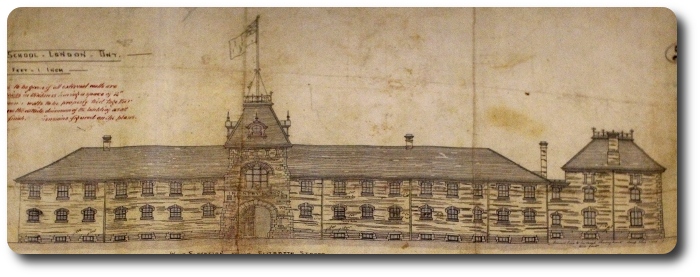
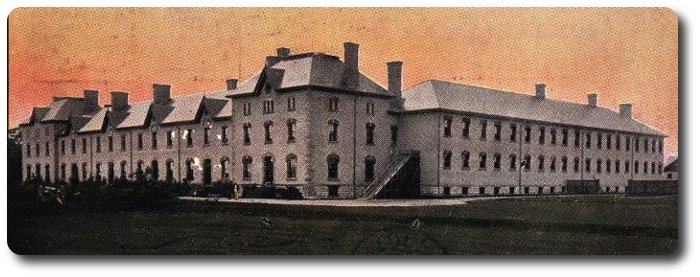

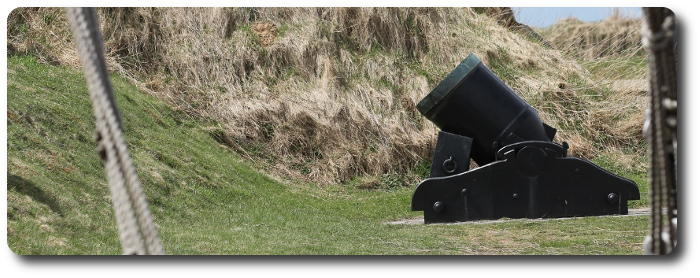

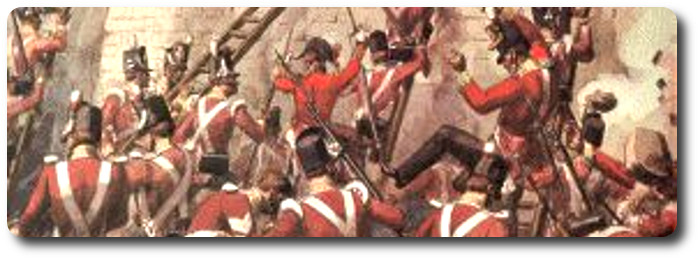
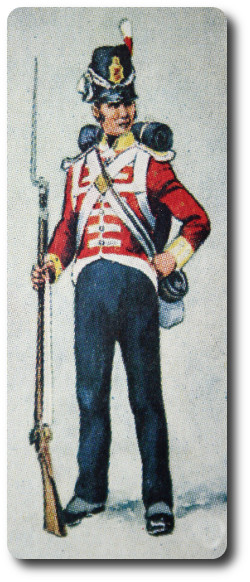 Inside the Regiment; The Officers and Men of the 30th Regiment During the Revolutionary and Napoleonic Wars, Carole Divall, 2011
Inside the Regiment; The Officers and Men of the 30th Regiment During the Revolutionary and Napoleonic Wars, Carole Divall, 2011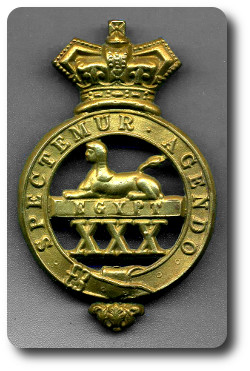 The daily drink allowance was five pints of small beer, which on campaign would be converted into whatever happened to be the local drink. The Portuguese wondered at the British soldiers' capacity for drinking the rough red wine which they themselves were reluctant to touch; while in India the native arrack was the cause of much indiscipline. There is evidence to suggest that some soldiers would willingly have starved themselves in order to have more money for drink, but for the system of messing which put men into groups who cooked and shared the food in rotation. This made it impossible for the individual soldier to forgo his food Furthermore, the officer of the day, as part of his duties, was required to inspect kettles at the hour appointed for cooking, while supervising messing arrangements was one of the general duties of all company officers.
The daily drink allowance was five pints of small beer, which on campaign would be converted into whatever happened to be the local drink. The Portuguese wondered at the British soldiers' capacity for drinking the rough red wine which they themselves were reluctant to touch; while in India the native arrack was the cause of much indiscipline. There is evidence to suggest that some soldiers would willingly have starved themselves in order to have more money for drink, but for the system of messing which put men into groups who cooked and shared the food in rotation. This made it impossible for the individual soldier to forgo his food Furthermore, the officer of the day, as part of his duties, was required to inspect kettles at the hour appointed for cooking, while supervising messing arrangements was one of the general duties of all company officers.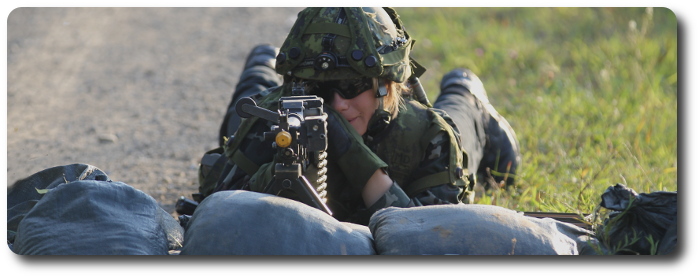


 Trench Warfare; A Manual for Officers and Men,, J.S. Smith, Second Lieutenant with the British Expeditionary Force, E.P. Dutton & Co., 1917.
Trench Warfare; A Manual for Officers and Men,, J.S. Smith, Second Lieutenant with the British Expeditionary Force, E.P. Dutton & Co., 1917.


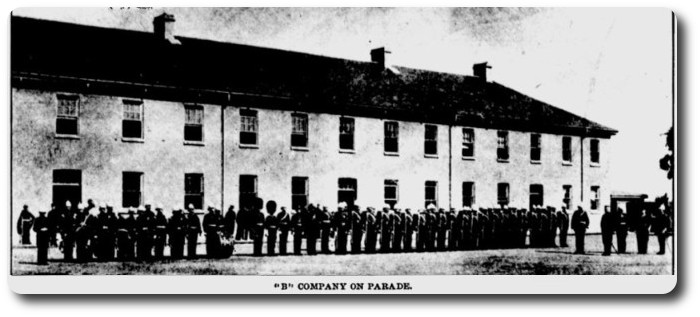

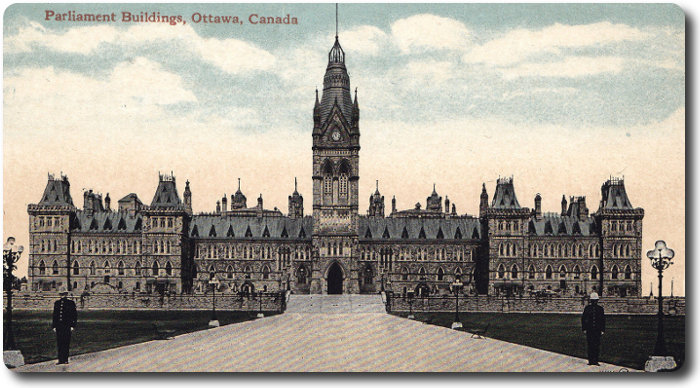

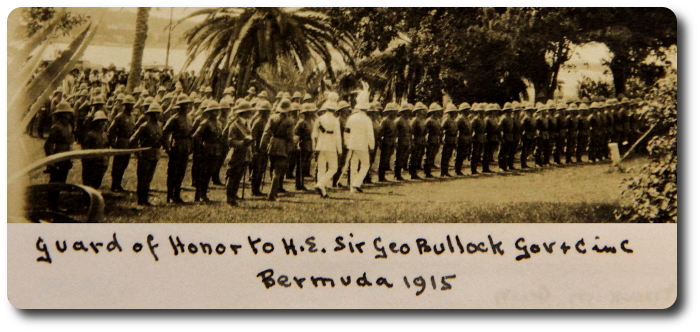
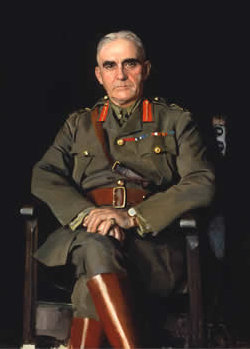 The following is a statement by
The following is a statement by 
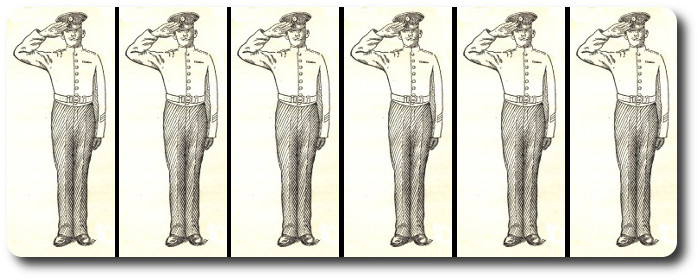
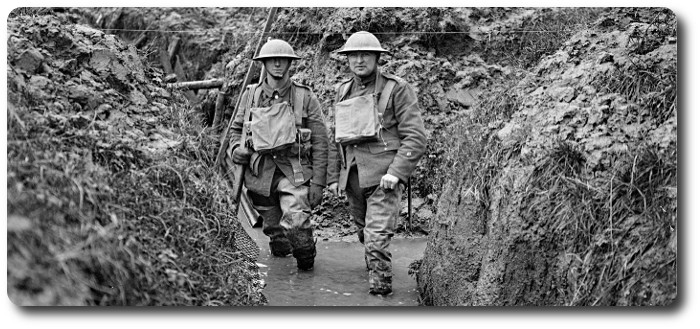
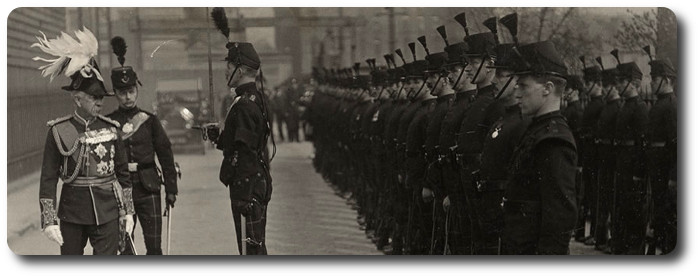
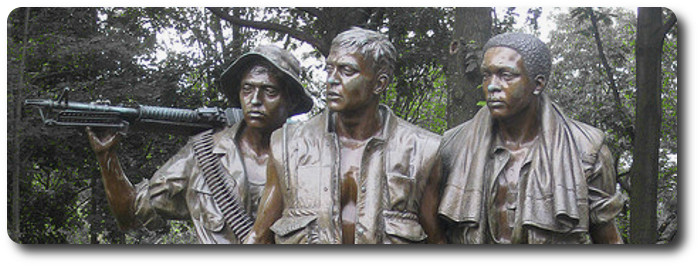
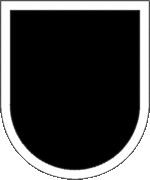 Combat Recon Manual, Republic of Vietnam; 1970
Combat Recon Manual, Republic of Vietnam; 1970
